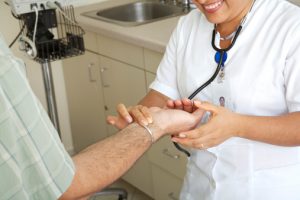 Have 30 seconds? We’re sure you do. Well, 30 seconds is all it takes to perform a simple at-home test to get an insight into your current state of health – and even a sneak peek into the future. A Harvard-based study has found checking your resting heart rate (RHR) can be a quick and easy way to gauge the functioning of your heart muscle. But before we get into what the test is all about, let’s first take a look at what exactly resting heart rate is and why it matters.
Have 30 seconds? We’re sure you do. Well, 30 seconds is all it takes to perform a simple at-home test to get an insight into your current state of health – and even a sneak peek into the future. A Harvard-based study has found checking your resting heart rate (RHR) can be a quick and easy way to gauge the functioning of your heart muscle. But before we get into what the test is all about, let’s first take a look at what exactly resting heart rate is and why it matters.
What is resting heart rate?
Resting heart rate is just as important as checking your blood pressure or cholesterol numbers. Dr. Jason Wasfy, director of quality and analytics at Harvard-affiliated Massachusetts General Hospital Heart Center, explained, “In certain cases, a lower RHR can mean a higher degree of physical fitness, which is associated with reduced rates of cardiac events like heart attacks. However, a high RHR could be a sign of an increased risk of cardiac risk in some situations, as the more beats your heart has to take eventually takes a toll on its overall function.”
Advertisement
Research has shown that a resting heart rate closer to the top of the 60 to 100 beats per minute (bpm) range increases a person’s risk for cardiovascular disease and early death.
A 2013 study examined the heart health of 3,000 men for 16 years and found that a higher RHR was associated with lower physical fitness and higher blood pressure, body weight, and circulating blood fats. Furthermore, the higher the RHR, the greater the probability of a premature death. A resting heart rate between 81 and 90 bpm was found to double one’s risk of early mortality. The risk triples after 90 bpm.
Normally, a lower resting heart rate implies better physical fitness, but for some it can also be a sign of illness causing dizziness and fatigue. Dr. Wasfy added, “This may be the result of the electrical nodes of the heart aging or not transmitting electrical signals correctly. You should report these symptoms to your healthcare provider.”
How to check your resting heart rate
Checking your resting heart rate is really simple and only requires two fingers and a watch. First, place two fingers on the inside of your wrist and locate your pulse. Use the watch as time guidance, and for 30 seconds count how many beats you feel. To get your beats per minute, double the number you counted in the 30-second time period.
This may be challenging at first, so you may have to give this a try a few times to ensure you are getting a correct reading. A healthy resting heart rate is anywhere between 60 and 100 bpm.
Advertisement
Dr. Wasfy recommends checking your RHR a few times a week at different times of the day as RHR can be heavily influenced by other factors, like being under stress of taking antidepressants.
If you are finding your RHR is often irregular, you should bring this to your doctor’s attention to take a deeper look at your cardiovascular health.
One thing that can help lower your RHR is regular exercise. As Dr. Wasfy put it, “Even small amounts of exercise can make a change.”
